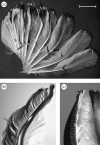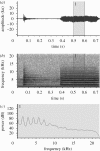Resonating feathers produce courtship song
- PMID: 19906670
- PMCID: PMC2842718
- DOI: 10.1098/rspb.2009.1576
Resonating feathers produce courtship song
Abstract
Male Club-winged Manakins, Machaeropterus deliciosus (Aves: Pipridae), produce a sustained tonal sound with specialized wing feathers. The fundamental frequency of the sound produced in nature is approximately 1500 Hz and is hypothesized to result from excitation of resonance in the feathers' hypertrophied shafts. We used laser Doppler vibrometry to determine the resonant properties of male Club-winged Manakin's wing feathers, as well as those of two unspecialized manakin species. The modified wing feathers exhibit a response peak near 1500 Hz, and unusually high Q-values (a measure of resonant tuning) for biological objects (Q up to 27). The unmodified wing feathers of the Club-winged Manakin do not exhibit strong resonant properties when measured in isolation. However, when measured still attached to the modified feathers (nine feathers held adjacent by an intact ligament), they resonate together as a unit near 1500 Hz, and the wing produces a second harmonic of similar or greater amplitude than the fundamental. The feathers of the control species also exhibit resonant peaks around 1500 Hz, but these are significantly weaker, the wing does not resonate as a unit and no harmonics are produced. These results lend critical support to the resonant stridulation hypothesis of sound production in M. deliciosus.
Figures





Similar articles
-
Courting bird sings with stridulating wing feathers.Science. 2005 Jul 29;309(5735):736. doi: 10.1126/science.1111701. Science. 2005. PMID: 16051789
-
Smithornis broadbills produce loud wing song by aeroelastic flutter of medial primary wing feathers.J Exp Biol. 2016 Apr;219(Pt 7):1069-75. doi: 10.1242/jeb.131664. J Exp Biol. 2016. PMID: 27030781
-
Aeroelastic flutter produces hummingbird feather songs.Science. 2011 Sep 9;333(6048):1430-3. doi: 10.1126/science.1205222. Science. 2011. PMID: 21903810
-
Courtship song analysis of Drosophila muscle mutants.Methods. 2012 Jan;56(1):87-94. doi: 10.1016/j.ymeth.2011.09.007. Epub 2011 Sep 16. Methods. 2012. PMID: 21945578 Review.
-
Resonators in insect sound production: how insects produce loud pure-tone songs.J Exp Biol. 1999 Dec;202(Pt 23):3347-57. doi: 10.1242/jeb.202.23.3347. J Exp Biol. 1999. PMID: 10562517 Review.
Cited by
-
Growling from the gut: co-option of the gastric mill for acoustic communication in ghost crabs.Proc Biol Sci. 2019 Sep 11;286(1910):20191161. doi: 10.1098/rspb.2019.1161. Epub 2019 Sep 11. Proc Biol Sci. 2019. PMID: 31506058 Free PMC article.
-
An atypical mating system in a neotropical manakin.R Soc Open Sci. 2020 Jan 8;7(1):191548. doi: 10.1098/rsos.191548. eCollection 2020 Jan. R Soc Open Sci. 2020. PMID: 32218973 Free PMC article.
-
Harmonic hopping, and both punctuated and gradual evolution of acoustic characters in Selasphorus hummingbird tail-feathers.PLoS One. 2014 Apr 10;9(4):e93829. doi: 10.1371/journal.pone.0093829. eCollection 2014. PLoS One. 2014. PMID: 24722049 Free PMC article.
-
Harnessing vocal patterns for social communication.Curr Opin Neurobiol. 2014 Oct;28:34-41. doi: 10.1016/j.conb.2014.06.006. Epub 2014 Jul 2. Curr Opin Neurobiol. 2014. PMID: 24995669 Free PMC article. Review.
-
Shared developmental and evolutionary origins for neural basis of vocal-acoustic and pectoral-gestural signaling.Proc Natl Acad Sci U S A. 2012 Jun 26;109 Suppl 1(Suppl 1):10677-84. doi: 10.1073/pnas.1201886109. Epub 2012 Jun 20. Proc Natl Acad Sci U S A. 2012. PMID: 22723366 Free PMC article. Review.
References
-
- Bailey W. J.1978Resonant wing systems in the Australian whistling moth Hecatesia (Agaristidae, Lepidoptera). Nature 272, 444–446 (doi:10.1038/272444a0) - DOI
-
- Bennet-Clark H. C.1975Sound production in insects. Sci. Prog. 62, 263–283 - PubMed
-
- Bostwick K. S.2000Display behaviors, mechanical sounds, and evolutionary relationships of the Club-winged Manakin (Machaeropterus deliciosus). Auk 117, 465–478 (doi:10.1642/0004-8038(2000)117[0465:DBMSAE]2.0.CO;2) - DOI
-
- Bostwick K. S., Prum R. O.2003High-speed video analysis of wing-snapping in two manakin clades (Pipridae: Aves). J. Exp. Biol. 206, 3693–3706 (doi:10.1242/jeb.00598) - DOI - PubMed
-
- Bostwick K. S., Prum R. O.2005Courting bird sings with stridulating wing feathers. Science 309, 736 (doi:10.1126/science.1111701) - DOI - PubMed
Publication types
MeSH terms
Grants and funding
LinkOut - more resources
Full Text Sources

